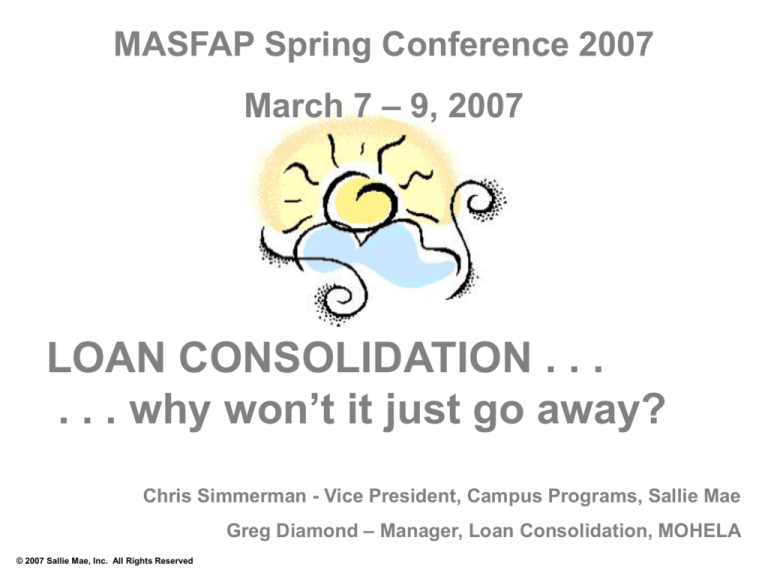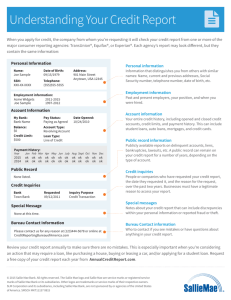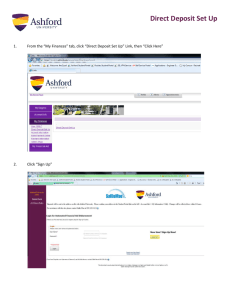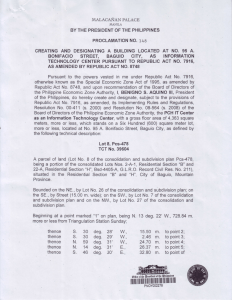
MASFAP Spring Conference 2007
March 7 – 9, 2007
LOAN CONSOLIDATION . . .
. . . why won’t it just go away?
Chris Simmerman - Vice President, Campus Programs, Sallie Mae
Greg Diamond – Manager, Loan Consolidation, MOHELA
© 2007 Sallie Mae, Inc. All Rights Reserved
Agenda
•
•
•
•
•
Welcome
Consolidation – Past and Present
Assessing the Value of Loan Consolidation
Consolidation - Future
Questions & Answers
© 2007 Sallie Mae, Inc. All Rights Reserved
Consolidation – Past and Present
HERA and ESAA impact
© 2007 Sallie Mae, Inc. All Rights Reserved
This Past Consolidation Season
• Many factors influenced the tremendous demand
– Another significant increase in variable interest rates
– Impending elimination of in-school / early repayment
consolidation options
– Elimination of single holder rule
– Intense marketing to borrowers
• Run up to July 1st this year was much like last year,
but things went smoother
– Industry was better prepared
– Borrowers were more familiar with process
– Schools / lenders / guarantors were able to provide
more education
© 2007 Sallie Mae, Inc. All Rights Reserved
Consolidation Changes
• Effective July 2006, the following changes directly
affected Federal Student Loan Consolidation:
– Elimination of in-school consolidation in DL and early
repayment consolidation in FFEL
• Consolidation permitted only when loans are in a grace or
repayment status, including deferment or forbearance
– Elimination of spousal consolidation
– Termination of consolidation eligibility upon receipt of a
consolidation loan in either the FFEL or DL program, unless
borrower meets certain specific conditions
– Mandates parallel terms between FFEL and DL
consolidation loans (except as explicitly noted)
– Elimination of Single Holder rule
• (effective June 15, 2006)
© 2007 Sallie Mae, Inc. All Rights Reserved
Consolidation Changes
• Effective July 2006, the following change indirectly
affected Federal Student Loan Consolidation:
– Fixed interest rates for Stafford and PLUS loans
• Stafford loans have a fixed rate of 6.8%
• FFEL PLUS loans, including Grad PLUS, have a fixed rate of
8.5%
• DL PLUS loans have a fixed rate of 7.9%
– Consolidation interest rate cap of 8.25% may be
advantageous for PLUS borrowers
© 2007 Sallie Mae, Inc. All Rights Reserved
What did NOT Change
• Consolidation interest rate
– Consolidation loans have a fixed interest rate for the life
of the loan
– To determine the fixed rate, a weighted-average is computed
based on current interest rates of underlying loans
• Calculated rate is rounded up to the nearest 1/8th percent
– The interest rate is capped at 8.25%
– Special rules apply to the portion of a FFEL consolidation
loan comprised of HEAL loans
© 2007 Sallie Mae, Inc. All Rights Reserved
Consolidation Interest Rate
• Consolidation interest rate
– Fixed weighted average of the loans consolidated, rounded up to
the nearest 1/8th percent, with a maximum rate of 8.25%
What is Weighted Average?
$25,625
C
O
N
S
O
L
I
D
A
T
I
O
N
2.875%
$25,625
x
0.02875 =
$737
$12,000
x
0.08500 =
$1,020
$8,000 x
0.06800 =
$544
$6,500 x
0.06540 =
$425
$5,000 x
0.05000 =
$250
----------------------------------------------------------$57,125
$2,976
----------------------------------------------------------$2,976 ÷ $57,125 = 0.05209
$12,000
GRAD PLUS
$8,000
$6,500
$5,000
STAFFORD STAFFORD PERKINS
8.500%
6.800%
6.540%
or 5.209%
----------------------------------------------------------5.209% rounded up to the
nearest 1/8 % = 5.250%
5.000%
Note: Special rules apply to consolidation loans that include
HEAL loans
© 2007 Sallie Mae, Inc. All Rights Reserved
Loan Portfolio Considerations
• 2006 / 2007 Borrower Loan Portfolio
– May contain any or all of the following:
• Consolidation loan with a fixed rate
• Perkins Loan with a fixed rate
• Stafford loan with variable rate
• Stafford loan with a fixed rate
• PLUS loan with variable rate
• PLUS loan with a fixed rate
– Includes Grad PLUS
• Private loan with variable rate
© 2007 Sallie Mae, Inc. All Rights Reserved
Grad PLUS
• Same program as the PLUS loan, but available to
graduate and professional students
• Fixed interest rate of 8.5%
– Consolidation interest rate cap of 8.25%
• Consolidation available after full disbursement
of loan – even if student still enrolled
• Deferment available while student is enrolled
in school
© 2007 Sallie Mae, Inc. All Rights Reserved
Timing Considerations
• Timing
– June 30th may no longer be a critical deadline
• For borrowers with fixed rate loans
• For borrowers who already consolidated
– June 30th, 2007, is important for those graduating who
still have variable rate Stafford and PLUS loans
• Can consider locking in at today’s rate or allowing the
loans to remain variable
• Wait to see the new 2007-08 Stafford and PLUS variable
rates published in early June
© 2007 Sallie Mae, Inc. All Rights Reserved
Grace Period Considerations
• Grace Period
– 2007 graduates may have grace period considerations
• Those who consolidated through early repayment
consolidation forfeited their grace period on consolidated
loans
– Repayment begins immediately after separation
• Those who borrowed in AY 2006-2007 may have at least one
Stafford loan with a grace period
– Borrowers need to be aware of their loan portfolio and be
prepared to manage loans entering or re-entering
repayment at different times
© 2007 Sallie Mae, Inc. All Rights Reserved
Benefits Considerations
• Borrower Benefits
– Borrowers who previously consolidated typically forfeited
any underlying Stafford benefits
• New consolidation benefits may apply
– 2007 graduates with Stafford loans
• Need to determine the “cash value” of the benefits on those
loans before deciding to consolidate
• Evaluate whether to earn a benefit, such as a principal credit
/ rebate, before consolidating
– Have the lender define the “cash value” of the benefit
being offered
© 2007 Sallie Mae, Inc. All Rights Reserved
Assessing the Value of Consolidation
Is consolidation still a viable repayment option?
© 2007 Sallie Mae, Inc. All Rights Reserved
Debt Management Considerations
• The decision to consolidate is no longer solely
interest rate driven. Focus shifts to Debt
Management
– In a fixed rate environment borrowers need to consider:
• Timing and benefits
• Longer repayment terms
• Smaller monthly payments
• Assistance with loan portfolio management
© 2007 Sallie Mae, Inc. All Rights Reserved
Debt Management Considerations
•
Financial advisors typically recommend that student loan debt
payments be less than 8% - 10% monthly gross income
Annual
Income
Monthly
Income
$30,000
Maximum Student Loan Payment At:
8%
10%
15%
$2,500
$200
$250
$375
$50,000
$4,167
$333
$417
$625
$75,000
$6,250
$500
$625
$938
$100,000
$8,333
$667
$833
$1,250
CAUTION
ALERT
WARNING
© 2007 Sallie Mae, Inc. All Rights Reserved
Consolidation Considerations
• Federal Loan Consolidation is no longer a “one size
fits all” solution
– When is consolidation a good consideration?
• When lower monthly payments allow borrower to focus on
repaying higher interest rate debts
• When long term payment relief is necessary
• When interest rates are low and can be locked in
• When solid borrower benefits make a difference
• When loan forgiveness is not an option
© 2007 Sallie Mae, Inc. All Rights Reserved
Consolidation Considerations
• As the marketing to borrowers intensifies, many will
seek guidance from the FAO
– Borrowers should consider that:
• Repayment can be a long-term relationship
• Many, if not most, borrowers cannot reconsolidate under
current rules
• Many consolidation marketers are not the lenders
• Ask who the lender / loan holder and loan servicer will
actually be and whether this can change
• Borrower benefits may look too good to be true and require
reading the fine print
© 2007 Sallie Mae, Inc. All Rights Reserved
Assessing the Value
• Payment amount comparison
– Consider what the borrower can reasonably afford to pay
• Interest cost comparison
– Determine the overall cost the borrower is willing to incur
• Significance of borrower benefits
– Borrowers may delay consolidation to take advantage of
underlying loan benefits
– By consolidating later in the loan life-cycle, borrowers could
reap rewards twice!
© 2007 Sallie Mae, Inc. All Rights Reserved
Consolidation - Future
Is the consolidation hype really over?
© 2007 Sallie Mae, Inc. All Rights Reserved
Loan Consolidation Landscape
• Consolidation environment in the industry has
fundamentally changed
– Loan interest rate environment spurred demand for
consolidation; new entrants
– Elimination of single holder rule means competition will
continue to increase, new entrants will likely stay
• Marketing activities are getting more aggressive and,
in some cases, reckless
–
–
–
–
–
Bypassing the financial aid office
Pushing consolidation in all cases
Recruiting students to market
Offering direct financial incentives to prospective applicants
Exploiting state “open records” laws
© 2007 Sallie Mae, Inc. All Rights Reserved
What This Means for Schools
• Increased marketing activities on campus and
directly to students
• More lenders / brokers / consolidators working with
students while they are enrolled in school
• Possibility that current lenders / guarantors will not
be able to provide same level of service / benefits
• Cohort default rate could be negatively impacted
• Student and parent borrowers more confused about
what to do
© 2007 Sallie Mae, Inc. All Rights Reserved
What This Means for Guarantors
• Uncertainty concerning repayment base; possible
impact on cohort default rate
• May impact ability to provide additional services
to borrowers
• Focus may shift from being the guarantor at
origination to being the guarantor at consolidation
• Many guarantors are relaxing their consolidation
waivers in order to pick up additional loan volume to
stabilize their portfolios
© 2007 Sallie Mae, Inc. All Rights Reserved
10 Fastest Growing Consolidation Guarantors*
•
Percentage Growth Rate FY ’04-05 vs. FY ’05-06
Rank
Guarantor
% Growth
1.
Georgia (GSFC)
2.
California (CSAC / EdFund)
313 %
3.
North Carolina (MCSEAA)
128 %
4.
Vermont (VSAC)
106 %
5.
Iowa (ICSAC)
95 %
6.
Wisconsin (Great Lakes)
88 %
7.
New Mexico (NMEAF)
86 %
8.
Pennsylvania (PHEAA/AES)
81 %
9.
Massachusetts (ASA)
75 %
10.
ECMC (Virginia / Oregon)
51 %
USA Funds (USAF)
36 %
Missouri (MDHE)
33 %
*Based upon fist 9 months of NSLDS data through June 2006
© 2007 Sallie Mae, Inc. All Rights Reserved
1,150 %
What This Means for Lenders
• Increased competition from existing student loan
industry lenders and from new entrants
– Lenders, marketers, brokers, eligible lender trusts
• Will need to reexamine the ability to provide front
end benefits if the loans are consolidated away as
soon an the borrower enters repayment
– or while still in school; Grad PLUS or deferred loans
• Activities of marketers / brokers may place
guarantee at risk if the activities violate
regulations/laws
© 2007 Sallie Mae, Inc. All Rights Reserved
10 Fastest Growing Consolidation Lenders*
•
Percentage Growth Rate FY ’04-05 vs. FY ’05-06
Rank
Lender
% Growth
1.
Graduate Leverage
2.
NextStudent
413 %
3.
Academic Loan Group
323 %
4.
Pacific Loan Processors
294 %
5.
Indiana Secondary Market
253 %
6.
Student Loan XPress
116 %
7.
Iowa Student Loan Liquidity Corp.
81 %
8.
Access Group
79 %
9.
Vermont Student Assistance Corp.
74 %
10.
Bank of America
68 %
MOHELA
63 %
Sallie Mae
10 %
*Based upon NSLDS data as of September 2006
© 2007 Sallie Mae, Inc. All Rights Reserved
1,202 %
What This Means for Borrowers
• Can consolidate with any eligible lender
• Will be a prime marketing target while in school and
when entering repayment
• Will have a wide variety of choices and will need to
carefully consider all options and implications
• Will look to the financial aid office for answers and
for advice
• May be more confused than ever
© 2007 Sallie Mae, Inc. All Rights Reserved
What This Means for the Industry
• Environment has fundamentally changed
• Participants will evaluate how to best operate in the
new landscape
• Will need to proactively address these issues
– Education and planning are key
• We can either drive the process or just go along for
the ride
© 2007 Sallie Mae, Inc. All Rights Reserved
What We Should Do
• Based on what we have learned and shared today
concerning the current and changing loan
consolidation environment, what should we do?
–
–
–
–
–
As schools
As lenders
As guarantors
As borrowers
As an industry
© 2007 Sallie Mae, Inc. All Rights Reserved
Resources
© 2007 Sallie Mae, Inc. All Rights Reserved
Additional Considerations
• Know The Facts About Consolidation… AND share
them with your staff and students:
–
–
–
–
Emails
Entrance & Exit Counseling
Letters
Consolidation Seminars for Students
• Proactively addressing this important issue will
serve your student and parent borrowers well and
prevent problems for your office!
© 2007 Sallie Mae, Inc. All Rights Reserved
Final Thoughts
• As long-time participants and service providers in
the student loan industry, we have a responsibility to
work with other industry leaders to address these
issues
• Providing educational services, materials and
resources to help borrowers successfully manage
their education related debt is critical
• Consider adding consolidation related information to
your financial aid office web-site
• Consider consolidation specific e-mail
communications to your student and parent
borrowers
© 2007 Sallie Mae, Inc. All Rights Reserved
Resources
• Guarantor and lender materials
• Internet
–
–
–
–
www.mapping-your-future.org
www.salliemae.com/consolidation
www.mohela.com/consolidation
www.finaid.org
© 2007 Sallie Mae, Inc. All Rights Reserved
© 2007 Sallie Mae, Inc. All Rights Reserved
Thank you!
© 2007 Sallie Mae, Inc. All Rights Reserved






